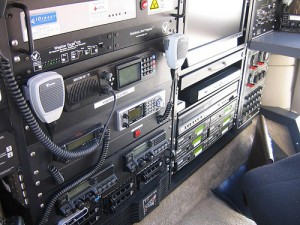Communication Options During A Disaster
One of the most underrated aspects of preparedness is communications. I want to throw out some of the main options for your consideration. I’m going to split these into two categories: Receive only, and Transmit/Receive.
Receive Only
Receivers are great for keeping informed.
AM/FM Radio
Just about every household in America has at least one AM/FM radio, and most cars also have working radios. While these may not be completely useful during some disasters, for the most part they’ll be a good source of information. You should identify news stations ahead of time and make sure that you’ve either memorized them or have a cheat sheet written down for them. If the Emergency Alert System is working, you’ll hear it on just about every station, but you’ll want to know where to hear real news as well.
Weather Radio
Weather Radio will provide you with specific weather related information straight from the National Weather Service. This can be very useful and will help you understand what’s going on during a natural disaster. You’ll also hear EAS broadcasts on weather radio, which is an added bonus. I highly recommend having at least one.
Scanners
Less useful as they once were, scanners can help you hear what’s going on around you. Beware though, many of the things you’ll hear will be unverifiable and could be completely inaccurate. Take whatever you hear with a grain of salt.
Transmit/Receive
You’ll want to talk to other people at some point, even if you’re just talking amongst yourselves. Some of the methods for enabling bidirectional communication are:
Whistles 
These are cheap, everyone can use them and can be easily carried on your key rings, go-kits, or anything. The universal signal for help is just three long blasts on your whistle.
Phones
A good old fashioned land line can withstand a tremendous amount of punishment. Having one around is a good idea. But honestly, I don’t have one because our provider uses fiber optic lines. So be careful, even if you think you have one, you might not! Another problem with phones, land line or cellular, is that in most disaster scenarios they will initially be swamped with people trying to make calls. You will NOT be able to get through to anyone. Or the government will jam the lines, as to clear all available lines for emergency communications between local, state, and federal agencies. So just be patient. Bonus Tip:Use text messaging if you can’t call through. Text messages ride empty space in the communications between your cell phone and the cellular towers. Since they’re low bandwidth, they’ll often get through just fine when a regular call can’t.
Family Radio Service (FRS)
Family Radio Service is your childhood walkie-talkie. It runs on the FM band, and doesn’t suffer the kind of interference you get with a CB radio or the older walkie-talkies. FRS transmitters are limited to 0.5 watts, so they just don’t get a ton of range. You can usually find fairly inexpensive FRS radios at sporting goods stores. Many of them claim to have 30-40 mile ranges, but my practical experience says a few miles at BEST and you should plan on no more than a half a mile or so. You’ll want to test these out in your area to be sure.
General Mobile Radio Service (GMRS)
This is similar to FRS, but you have to have a license and you can use higher power transmitters. You can transmit up to 50 watts with a GMRS transmitter. Unfortunately without good antennas this doesn’t turn into significantly improved range. If you want to try it out, someone in the family has to have a license. $85 and a piece of paper will get it for you, no exam required. You can even get hybrid FRS/GMRS radios, which some people like. Me? I stick with FRS around the local area.
CB Radio
Everyone knows what a CB radio is. Lots of people have them around, and you can find a good CB radio at most swap meets/ flea markets. If you want a CB, you’ll need to get a good antenna. CB signals don’t propagate all that great with a hand-held radio with a smaller antenna. Invest in a good aftermarket antenna if you want to make this part of your communications plan. Tip: CB channel 9 is reserved for emergencies. Monitoring it during an event could provide you with good insights into what’s going on around you.
Long Range Communications/Amateur Radio
By far the most dependable source of communicating during natural disasters. Communicate with people all over the world, the international space station, or just across town. Regulated by the FCC, so a license is required to operate one. Penalties for allowing a non-amateur operator use your radio. Depending on the sophistication of your equipment, most certainly the height and clearance of your antennae, will determine the distance of your signal. HAM operators can be used in emergencies but are prohibited to translate public service announcements. From a hand held device to a room full of equipment and the internet, your interest in this mode of communication can vary greatly and so can cost. Radio frequencies reserved by the Federal Communications Commission (FCC) for use by hams are at intervals from just above the AM broadcast band all the way up into extremely high microwave frequency. HAM radios can be charged by car battery.
I'm a great believer that any tool that enhances communication has profound effects in terms of how people can learn from each other, and how they can achieve the kind of freedoms that they're interested in. --Bill Gates
Lapeer Ward Enrichment – September 2011 RCM

No comments:
Post a Comment